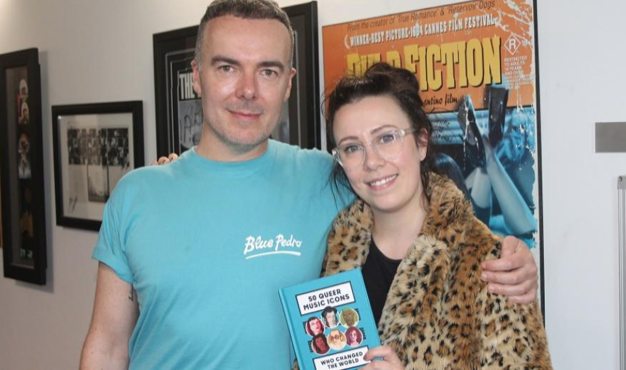“Queer artists have always been there” – Author Will Larnach-Jones talks his new book about LGBTIQ+ music icons

Tell us about your book; what inspired you to write it?
Bashing about some ideas with a good friend who’s a book editor. With so many things that have taken place in the last decade – both good and bad – for the queer community, it seemed prescient to do it that this time.
Does the book focus on queer icons who are musicians, or iconic queer musicians, or both!?
A bit of both. I focus largely on iconic musicians who happen to be queer, and then a handful of musicians who are queer icons. Some are both of course!
Was there a particular turning point in music history when queer musicians really started to be heard?
Many movements in modern music had queer artists at the helm. The likes of Ma Rainey and Bessie Smith brought blues from America’s South to a much larger audience.
There would be no rock’n’roll without Little Richard, who was a direct influence on The Beatles, The Rolling Stones and scores of others. He was also one of the first artists to play to mixed audiences in the US.
Also, Willie Mae Thornton’s version of ‘Houndog’ pre-dated Elvis’s and sold over a million in its own right.
Queer artists have always been there – it’s a case of mainstream society becoming more attuned to their cultural tropes, and the artists themselves accepting their own sexuality. Can you imagine that the housewives of Middle America swooned over Liberace? And in the 70s to mainstream audiences, The Village People seemed more like action heroes than gay clone stereotypes from Greenwich Village.
What was your first experience with queer musicians/queer music, and what kind of impact did it have on your ideas about music?
As a kid in the ’80s, there was a ton of great pop music. It seemed that for many artists their music and presentation went hand in hand. I remember Bowie’s ‘Ashes to Ashes’ video very well, and of course, the likes of Culture Club opened up a lot of questions.
I liked all the dress up stuff. Popstars should be beamed down from Mars, not wearing Juicy Couture tracksuits. ‘Smalltown Boy’ by Bronski Beat is such an important song, and its video mirroring Jimmy Somerville’s real-life experience of growing up gay and disenfranchised in mainstream society so powerful. I was too young to completely identify with it, but it was powerful and melancholy and made a lasting impression on me.
What lessons can the new generation of queer artists learn from the original trailblazers?
That the struggle is real and continues to be real. For every artist that finds acceptance, there’s another somewhere else shunned by their community.
Think about the disappearance and murder of out popstar Zelimkhan Bakaev in Chechnya just last year. There is no other explanation for his murder other than homophobia.
Who are the top five artists who had the most influence on music?
That’s entirely subjective! I think as a queer icon, Bowie had a huge influence on the decade of stars to follow in the ’80s. Little Richard obviously. Frank Ocean. Elton John is the ultimate songwriter. Tracy Chapman’s ‘Fast Car’ is a song that will be covered by all genres as long as there is music.
Personally, I think Pet Shop Boys brought together dance and pop in a way that hadn’t been done before. Their early stuff brought together influences such as Grandmaster Flash and Bobby O. That’s pretty cool.
And who are the queer artists who you feel are overlooked?
So many, and many not in this book. Jobriath is one who features – signing a massive deal with a hotshot manager, profoundly misunderstood by the press and public, his career nosediving and life ending in tragedy at the height of the AIDs crisis.
There’s speculation that Nick Drake was gay, I think there’s something in his music’s inherent melancholy that really speaks to me at least. He’s and Jobriath are examples of artists finding an audience after their passing. Arthur Russell too.
What are some of the biggest changes you’ve witnessed throughout your career in the way the music industry work with the queer community?
Well, major labels no longer calling their gay artists ‘faggots’ on marketing conference calls is a start. That only took about 50 years. Record labels aren’t stupid. The pink dollar has always supported so many artists – largely female pop stars – now queer artists are being embraced in their own.
I love seeing the likes of Troye Sivan being A&R-ed out of Australia and making such huge impact globally. I love that his fanbase is so robust and he creates an intelligent queer pop world all of his own. Sophie on Future Classic is great too. On an indie level, the likes of Chapter Music have supported so many good artists – many of whom happen to be within the queer community. Their ‘Strong Love’ compilation of early songs of gay liberation is both fascinating and important.
What do you foresee in the future for queer artistry?
More queer artists creating music and world’s on their own terms. Earlier this year, I saw Arca performing in London, and I love the fact that his performance, taking inleft electronica, forlorn singing, queer kink and BDSM references was just so fully embraced by a largely straight audience – no one batted an eyelid. Queer audiences enjoy straight acts and accept them for who they are, it’s nice to think that straight audiences are beginning to accept and be interested in queer artists too. Music is music!
































